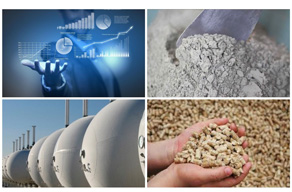Real-time commodity futures quotes
Futures are one of the popular financial instruments in the market, which is an agreement between two parties to buy or sell an asset in the future at a pre-agreed price.

They are widely used both for hedging risks and for speculative trading. The key characteristic of any futures contract is its quotation - the price at which this contract can be concluded at a given time.
A commodity futures quote is the current market price of a contract for a commodity or raw material, which is formed based on supply and demand.
The informer below displays such important indicators as - current price, change per day in dollars, change per day in percentage, time until the end of the contract:
Recommended brokers for futures trading.
Key indicators that can be displayed in commodity futures quotes
The online informer provides information only on basic indicators; if you want to get more complete information, use commodity futures quotes in the trading platform:

Bid Ask prices – the cost of opening sell and buy transactions at the current moment.
Spread is the difference between buying and selling or, in other words, the commission that a broker takes for opening a transaction on commodity futures.
Opening price (Open) - This is the first price of the futures at the beginning of the trading session. The opening price is an important reference point for traders, as it shows the starting point of trading for the current day.
Closing Price - This is the price at which the futures contract ends trading at the end of the trading session. Closing price is the most important indicator that helps traders evaluate the results of the day and predict possible market movements for the next day.
Maximum Price (High) - The maximum price for a certain period (for example, a day) reflects the highest level of demand for the futures contract. This indicator shows to what level the price can reach in conditions of increased demand.
Minimum price (Low) - The minimum futures price for the period demonstrates the lowest level of demand for the contract. Traders often use this indicator to analyze possible entry points into the market.
Depending on the brokerage company and the settings in the trading platform, other indicators of futures contract quotes, such as transaction volumes, margin, volatility, may be displayed.
Factors influencing commodity futures quotes
Economic Indicators - Important macroeconomic data such as inflation, unemployment rates and interest rates have a significant impact on futures prices.
Changes in the market for underlying assets - Since futures are linked to underlying assets (eg oil, gold, currencies), changes in the prices of these assets directly affect futures prices. An increase in the value of the underlying asset leads to an increase in futures prices for the asset.
Political instability - Geopolitical events, such as conflicts or changes in international trade agreements, can dramatically affect futures prices.
Natural disasters and weather conditions - Natural phenomena also have an impact on quotes. For example, a drought can boost futures prices for agricultural commodities such as wheat or corn.
Futures contracts are used not only for short-term trading, but also for long-term strategies. For example, investors can use futures to hedge their exposure to the stock or commodity markets.
Commodity futures quotes are an essential tool for assessing market conditions and making trading decisions. Knowing the basic indicators of quotes allows traders to better navigate market dynamics and use futures contracts with maximum benefit. Understanding the factors influencing quotes helps you not only protect your assets, but also profit from market fluctuations.

